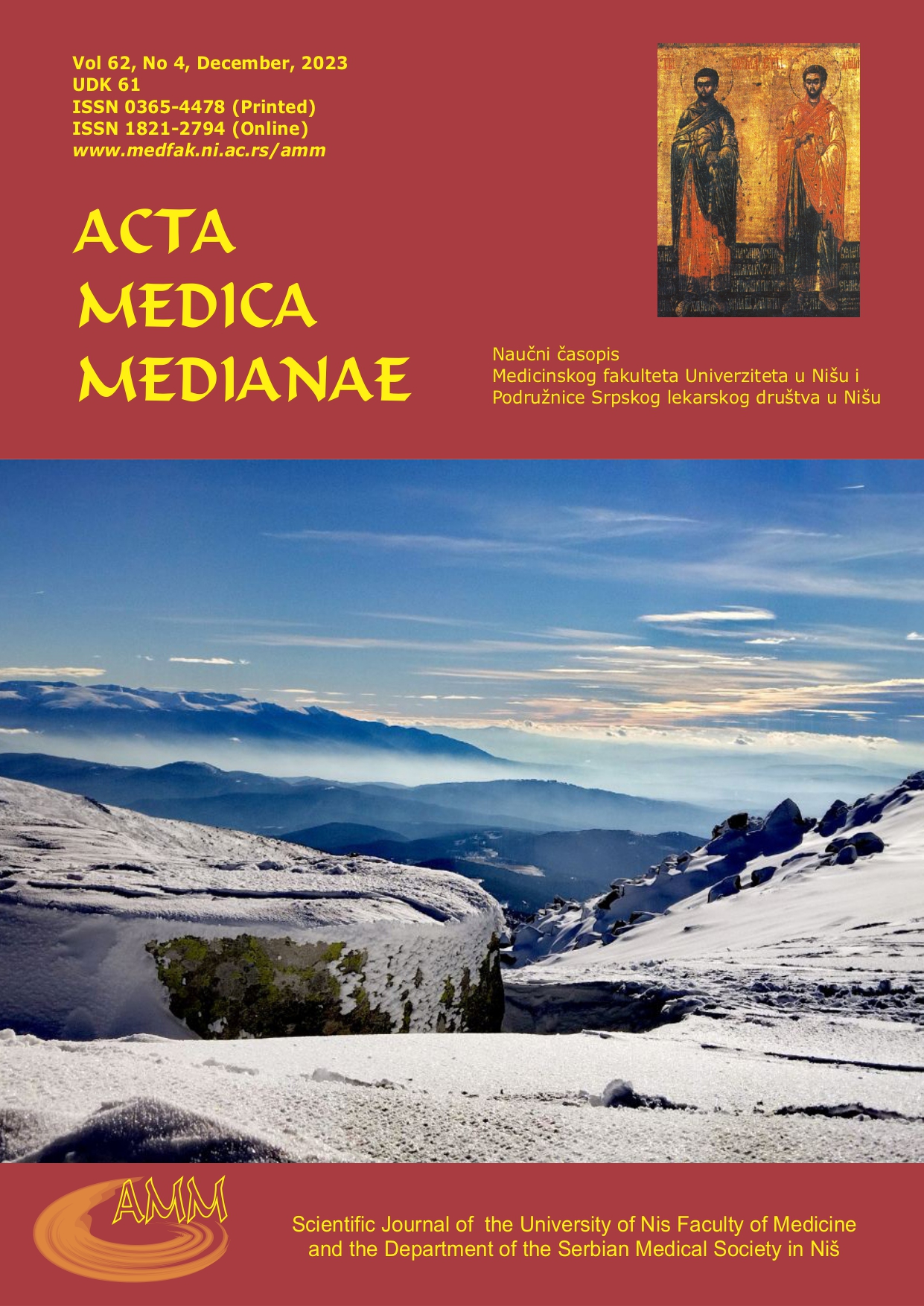BLEEDING ASSESSMENT TOOLS
Abstract
Bleeding Assessment Tools (BATs) are bleeding scoring systems used for screening and quantitative assessment of mild bleeding disorders. They consist of a standardized questionnaire and a scoring system that is used for the summation of the final score. In this review article, we have presented BATs that are applied in the area of hematology.
The earlier BATs were designed to distinguish patients with von Willebrand disease (VWD) from healthy individuals. Later modifications of the original Vicenza-BAT were developed in order to improve its specificity, precision, and flexibility, as well as to shorten the administration time. The most significant of these modifications is the International Society on Thrombosis and Hemostasis Bleeding Assessment Tool (ISTH-BAT), which is also validated for use in patients affected by hemophilia and inherited platelet disorders. ISTH-BAT score of ≥ 6 in adult females, ≥ 4 in adult males, and ≥ 3 in children is considered abnormal.
The WHO developed the first BAT for immune thrombocytopenia (ITP). However, more recently, the ITP International Working Group (IWG) designed the ITP-BAT. The IWG defines a severe or clinically relevant bleeding manifestation as an ITP-BAT SMOG index of S > 2 and/or M > 1 and/or O > 1. In 2016, a group of Chinese experts created a simple modification of the ITP-BAT, the ITP-2016. The values of the ITP-2016 Bleeding Score ≥ 5 indicate severe immune thrombocytopenia.
In the primary healthcare setting BATs serve as a valuable screening tool for discovering patients with bleeding disorders, who require further hematologic investigation.
References
Balduini CL, Cattaneo M, Fabris F, Gresele P, Iolascon A, Pulcinelli FM, et al. Inherited thrombocytopenias: a proposed diagnostic algorithm from the Italian Gruppo di Studio delle Piastrine. Haematologica 2003; 88(5): (582-592). [PubMed]
Benson G, Auerswald G, Dolan G, Duffy A, Hermans C, Ljung R et al. Diagnosis and care of patients with mild haemophilia: practical recommendations for clinical management. Blood Transfus 2018; 16(6): 535-544. [CrossRef][PubMed]
Boender J, Kruip MJHA, Leebeek FWG. A diagnostic approach to mild bleeding disorders. J Thromb Haemost 2016; 14(8): 1507-1516. [CrossRef][PubMed]
Borhany M, Fatima N, Abid M, Shamsi T, Othman M. Application of the ISTH bleeding score in hemophilia. Transfus Apher Sci 2018; 57(4): (556-560). [PubMed]
Duga S, Salomon O. Factor XI Deficiency. Semin Thromb Hemost 2009; 35(4): 416-425. [CrossRef][PubMed]
Elbatarny M, Mollah S, Grabell J, Bae S, Deforest M, Tuttle A et al. Normal range of bleeding scores for the ISTH-BAT: adult and pediatric data from the merging project. Haemophilia 2014; 20(6); 831-835. [CrossRef][PubMed]
Elbaz C, Sholzberg M. An illustrated review of bleeding assessment tools and common coagulation tests. Res Pract Thromb Haemost 2020; 4(5): 761-773. [CrossRef][PubMed]
Gresele P, Orsini S, Noris P, Falcinelli E, Alessi MC, Bury L et al.. Validation of the ISTH/SSC bleeding assessment tool for inherited platelet disorders: A communication from the Platelet Physiology SSC. J Thromb Haemost 2020; 18(3): (732-739). [CrossRef][PubMed]
Gresele P. Diagnosis of inherited platelet function disorders: guidance from the SSC of the ISTH. J Thromb Haemost 2015; 13(2): (314-322). [CrossRef][PubMed]
Huang J, Zeng B, Li X, Huang M, Zhan R. Comparative Study of the Clinical Application of 2 Bleeding Grading Systems for Pregnant Women With Immune Thrombocytopenia. Clin Appl Thromb Hemost 2020; 26: (1-4). [CrossRef][PubMed]
James PD, Mahlangu J, Bidlingmaier C, Mingot-Castellano ME, Chitlur M, Fogarty PF et al. Evaluation of the utility of the ISTH-BAT in haemophilia carriers: a multinational study. Haemophilia 2016; 22(6): (912-918). [CrossRef][PubMed]
Kistanguri G, McCrae KR. Immune Thrombocytopenia. Hematol Oncol Clin North Am (serial online) 2013; 27(3): (495-520). [CrossRef][PubMed]
Kohli R, Chaturvedi S. Epidemiology and Clinical Manifestations of Immune Thrombocytopenia. Hamostaseologie 2019; 39: (3)(238-249). [CrossRef][PubMed]
Li S, Fang Y, Li L, Lee A, Poon M, Zhao Y et al. Bleeding assessment in haemophilia carriers-High rates of bleeding after surgical abortion and intrauterine device placement: A multicentre study in China. Haemophilia 2020; 26(1): (122-128). [CrossRef][PubMed]
Makris M, Hermans C. The 2021 von Willebrand disease guidelines: Clarity and controversy. Haemophilia 2022; 28(1); 1-3. [CrossRef][PubMed]
Miller AB, Hoogstraten B, Staquet M, Winkler A. Reporting results of cancer treatment. Cancer 1981; 47(1): (207-214). [CrossRef][PubMed]
Nichols WL, Hultin MB, James AH, Manco-Johnson MJ, Montgomery RR, Ortel TL et al. von Willebrand disease (VWD): evidence-based diagnosis and management guidelines, the National Heart, Lung, and Blood Institute (NHLBI) Expert Panel report (USA). Haemophilia 2008; 14(2): 171-232. [CrossRef][PubMed]
Pai M. Acquired Hemophilia A. Hematol Oncol Clin North Am (serial online) 2021; 35(6): (1131-1142). [CrossRef][PubMed]
Rajić N. Von Willebrand disease - detection, diagnostics and treatment. Med Pregl 2022; 75(1): 147-151. [CrossRef]
Rodeghiero F, Castaman G, Dini E. Epidemiological Investigation of the Prevalence of von Willebrand΄s disease. Blood 1987; 69(2): 454-459. [CrossRef][PubMed]
Rodeghiero F, Michel M, Gernsheimer T, Ruggeri M, Blanchette V, Bussel JB et al. Standardization of bleeding assessment in immune thrombocytopenia: report from the International Working Group. Blood 2013; 121(14): (2596-2606). [CrossRef][PubMed]
Rodeghiero F, Tosetto A, Abshire T, Arnold DM, Coller B, James P et al.. ISTH/SSC bleeding assessment tool: a standardized questionnaire and a proposal for a new bleeding score for inherited bleeding disorders. J Thromb Haemost 2010; 8(9): 2063-2065. [CrossRef][PubMed]
Sang Y, Roest M, de Laat B, de Groot PG, Huskens D. Interplay between platelets and coagulation. Blood Rev 2021; 46: 100733. [CrossRef][PubMed]
Sholzberg M. Haemophilia commentary: The utility of BATs. Haemophilia 2018; 24(4): 522-524. [CrossRef][PubMed]
Thrombosis and Hemostasis Group, Chinese Society of Hematology, Chinese Medical Association. Chinese guideline on the diagnosis and management of adult primary immune thrombocytopenia (version 2020). Zhonghua Xue Ye Xue Za Zhi 2020; 41(8): (617-623). [CrossRef][PubMed]
Vučić M, Lilić B. Clinical significance of bleeding scoring systems. Med Pregl 2022; 75(1): 133-142. [CrossRef]
Xiao S, Liu Q, Hou M. Comparative study between two bleeding grading systems of primary immune thrombocytopenia. Zhonghua Xue Ye Xue Za Zhi 2017; 38(5): (394-398). [CrossRef][PubMed]

